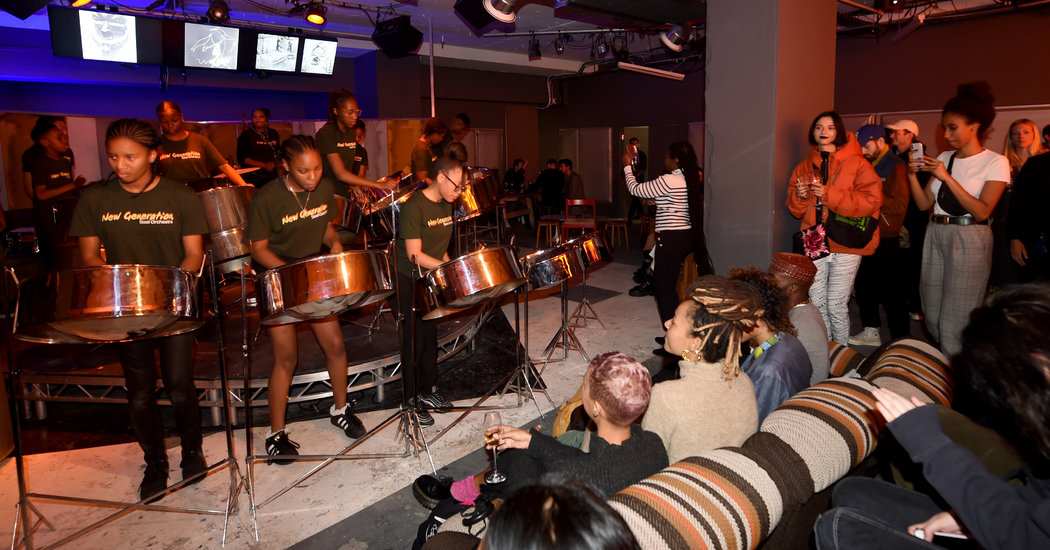
The It bag may be more like an old hat these days — at least when it comes to fashion’s front row. But exclusivity is not exactly out of style; it’s just no longer symbolized by something you can swing from your arm.
In 2020, partying with Prada is what counts. And it’s an experience money can’t buy.
This week Prada Mode, the Milanese luxury label’s roving private member’s club, has hit Paris.
Introduced in 2018, the club already landed in Miami and Hong Kong during Art Basel, and in London for Frieze. Now its fourth edition was to open for two days, Sunday and Monday, during the couture shows in the French capital, taking over the Art Nouveau restaurant Maxim’s on rue Royale, where the likes of Aristotle Onassis and the Duke and Duchess of Windsor once dined.
It is the latest iteration of luxury’s drive to own the experience economy, which has seen brands expand into hotels, cafes — and increasingly, form their own velvet-roped, insider-only communities.
“My interests often take me to think about projects beyond fashion,” Miuccia Prada wrote in a recent email. “Mode is one of these events, offering a familiar place to extend the art experience into the social; a place where people are welcome to think freely and discuss, not forget to have fun.”
Gaining entree to this mythical zone is not as straightforward as donning one of the label’s frumpy-chic coats. For the Paris iteration, about a thousand invitees were handpicked by the label, and include such names as Adèle Exarchopoulos, the French actress; Jake Chapman, the British artist; Gigi Hadid, the American model; and Alex Kapranos, the singer with the Scottish rock band Franz Ferdinand. It’s a way for the brand to dip its sling-backs into the haute couture crowd in a city where Prada isn’t on the runway.
“They want to present themselves as a junction, not necessarily between art and fashion but a new zone,” said Francesco Bonami, the Italian curator who popped by Prada Mode during its London stop in October. “It’s a different level, and hard to define.”
Once in, Prada Mode Paris members could hit the club any time over its two-day run (open from 9:30 a.m. to 2 a.m.), to experience site-specific artworks; join parties featuring live performances from the avant-garde composer William Basinski and the experimental musician Josiah Wise, who records as serpentwithfeet; and sample specialty dining from the French chef Bertrand Grébaut of the Paris restaurant Septime.
Also scheduled are panel discussions with leading theorists and practitioners focused on the history of facial recognition, concerns about government and corporate surveillance, and how artists and creators are responding to such programs.
“Making Faces,” an installation and live program for the event, was created by Kate Crawford, an artificial intelligence researcher and professor at New York University, and the artist and researcher Trevor Paglen. Speakers were to include Heather Dewey-Hagborg, an artist now based in New York and Dubai, and Hito Steyerl, a German artist, writer and filmmaker.
“What does it mean when your face becomes your passport? When it becomes analyzed and tracked?” Ms. Crawford said in a recent interview. She noted that the Prada Mode event would have particular significance at a time when France was poised to become the first European country to incorporate facial recognition technology into a mandatory digital identity for its citizens.
Another question might be: Why would a fashion brand suddenly want to become a gatekeeper of self-invented creative communities?
“Creating experiences that surround a brand through the customer journey acts as an antidote to commoditization and declining loyalty,” Caroline Bremner, head of travel at Euromonitor International, wrote in the market research company’s 2017 report “Experience More.”
Another 2017 Euromonitor report said: “Consumer’s expenses with experiences should increase from $5.8 trillion in 2016 to $8 trillion in 2030,” with experiences encompassing categories like leisure, recreation, travel and food services.
Prada’s efforts to create its own club community are the most recent in a growing trend among retailers.
In Milan, Giorgio Armani has a side gig as a nightclub impresario. His private club Giorgio’s was introduced in 2016 and says it has around 1,000 members worldwide. Last December it had its own pop-up at Harry’s Bar in London as host of one of the British Fashion Awards after-parties.
The Palazzo Ralph Lauren, a members-only club in Milan, opened in the fashion house’s Art Nouveau palazzo, Casa Campanini, in 2015. Here, a person need only be a valued client, or even just a friend of one, to belong. Members can shop from exclusive collections, enjoy perks like dining on its outdoor terrace with food prepared by a private chef and get priority reservations at any Ralph Lauren restaurant.
And Alfred Dunhill, the British luxury label, has its private club, called Alfred’s, at its men’s wear flagship store in Bourdon House, a Georgian mansion in the Mayfair that was the former London residence of the Duke of Westminster.
“In the end, these experiences are all about making customers feel special,” said Flavio Cereda-Parini, managing director of luxury and brand equity research for Jefferies Group, an investment bank and financial services company.
And the result? To make them, he said in a recent interview, “open their wallets more, and engender a sense of loyalty.”







